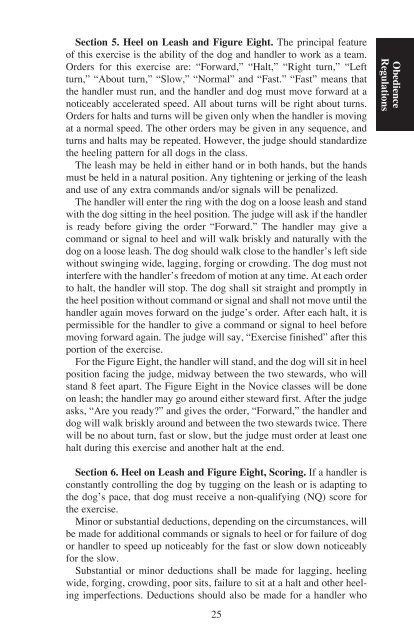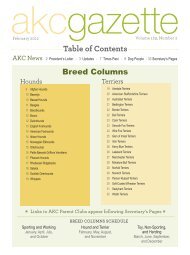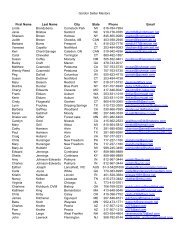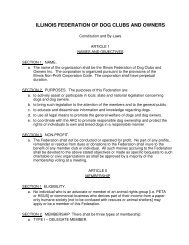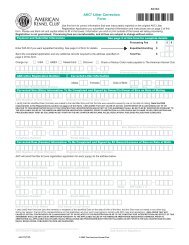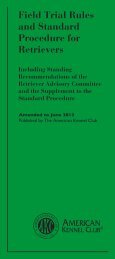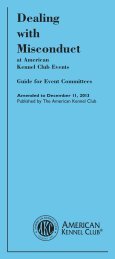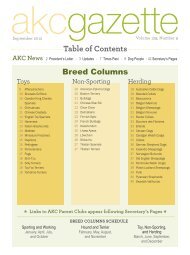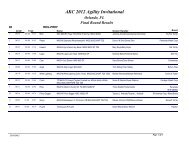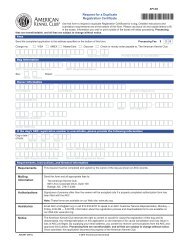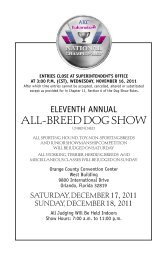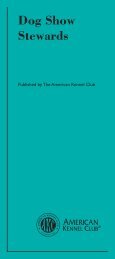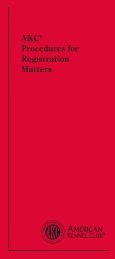Obedience Regulations - American Kennel Club
Obedience Regulations - American Kennel Club
Obedience Regulations - American Kennel Club
You also want an ePaper? Increase the reach of your titles
YUMPU automatically turns print PDFs into web optimized ePapers that Google loves.
Section 5. Heel on Leash and Figure Eight. the principal feature<br />
of this exercise is the ability of the dog and handler to work as a team.<br />
orders for this exercise are: “Forward,” “Halt,” “right turn,” “left<br />
turn,” “About turn,” “slow,” “normal” and “Fast.” “Fast” means that<br />
the handler must run, and the handler and dog must move forward at a<br />
noticeably accelerated speed. All about turns will be right about turns.<br />
orders for halts and turns will be given only when the handler is moving<br />
at a normal speed. the other orders may be given in any sequence, and<br />
turns and halts may be repeated. However, the judge should standardize<br />
the heeling pattern for all dogs in the class.<br />
the leash may be held in either hand or in both hands, but the hands<br />
must be held in a natural position. Any tightening or jerking of the leash<br />
and use of any extra commands and/or signals will be penalized.<br />
the handler will enter the ring with the dog on a loose leash and stand<br />
with the dog sitting in the heel position. the judge will ask if the handler<br />
is ready before giving the order “Forward.” the handler may give a<br />
command or signal to heel and will walk briskly and naturally with the<br />
dog on a loose leash. the dog should walk close to the handler’s left side<br />
without swinging wide, lagging, forging or crowding. the dog must not<br />
interfere with the handler’s freedom of motion at any time. At each order<br />
to halt, the handler will stop. the dog shall sit straight and promptly in<br />
the heel position without command or signal and shall not move until the<br />
handler again moves forward on the judge’s order. After each halt, it is<br />
permissible for the handler to give a command or signal to heel before<br />
moving forward again. the judge will say, “exercise finished” after this<br />
portion of the exercise.<br />
For the Figure eight, the handler will stand, and the dog will sit in heel<br />
position facing the judge, midway between the two stewards, who will<br />
stand 8 feet apart. the Figure eight in the novice classes will be done<br />
on leash; the handler may go around either steward first. After the judge<br />
asks, “Are you ready?” and gives the order, “Forward,” the handler and<br />
dog will walk briskly around and between the two stewards twice. there<br />
will be no about turn, fast or slow, but the judge must order at least one<br />
halt during this exercise and another halt at the end.<br />
Section 6. Heel on Leash and Figure Eight, Scoring. if a handler is<br />
constantly controlling the dog by tugging on the leash or is adapting to<br />
the dog’s pace, that dog must receive a non-qualifying (nQ) score for<br />
the exercise.<br />
minor or substantial deductions, depending on the circumstances, will<br />
be made for additional commands or signals to heel or for failure of dog<br />
or handler to speed up noticeably for the fast or slow down noticeably<br />
for the slow.<br />
substantial or minor deductions shall be made for lagging, heeling<br />
wide, forging, crowding, poor sits, failure to sit at a halt and other heeling<br />
imperfections. Deductions should also be made for a handler who<br />
25<br />
<strong>Obedience</strong><br />
<strong>Regulations</strong>


